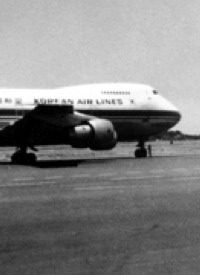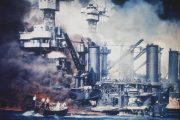
In the midst of public outcry over the decision by Scottish authorities to free Abdel Baset al-Megrahi, convicted in 1991 for his involvement in the 1988 bombing of Pan Am 103 over Lockerbie, Scotland, the anniversary of an older case of state-sponsored terrorism, the shooting down by KAL 007 by Soviet jet fighters in 1983, is almost forgotten by the media and public.
When a bomb planted by Libyan terrorists tore Pan Am flight 103 from the sky on December 21, 1988, 270 people — 259 of them on the plane and 11 more on the ground — were killed. When a Soviet MiG-23 fired two air-to-air missiles at Korean Air Lines flight 007 on September 1, 1983, 269 people were onboard. Because the bomb aboard the Pan Am flight detonated earlier than planned, it was possible for investigators to painstaking reconstruct the plane as part of the investigation to determine the perpetrators of the heinous crime. The Soviets, however, hampered the investigation of their own crime, with the result that substantial questions remain unanswered a generation later.
After KAL 007, President Reagan addressed the nation, referring to the incident as a “crime against humanity which must never be forgotten.”
However, within a year, Reagan’s administration was working to restore normal relations with the Soviet Union.
Among the passengers of KAL 007 was Rep. Larry McDonald (D-GA), who was both a member of the House of Representatives and chairman of the John Birch Society, but the “collateral damage” from the Soviet attack included another member of Congress: Senator Henry “Scoop” Jackson (D-WA), whose last public appearance was at a press conference denouncing the Soviet Union. Sen. Jackson died of an aortic aneurysm on September 1, 1983.
In a Foreword to Jeffrey St. John’s 1984 book on the KAL 007 attack, Day of the Cobra, Sen. Jesse Helms (R-N.C.) recounted meeting the family of Neil Grenfell from flight 007 while his own plane, KAL 015, was on the ground at the Anchorage airport at the same time as KAL 007, and his immediate emotional connection with the two Grenfell daughters: “In the quiet of the night, I can still hear those precious children laughing. I can feel their little arms around my neck. I can see them waving good-bye and blowing kisses to me as they departed. I simply cannot accept their deaths. My mind rejects any notion that a civilized country could wantonly, intentionally, premeditatedly shoot down an unarmed plane loaded with innocent men, women, and children.”
With time, Sen. Helms continued to make inquiry of Soviet, and later Russian, rulers seeking to determine what actually happened to the passengers of KAL 007. As was recounted for The New American last year,
In 1991, Senator Helms, as Minority Leader of the Senate Foreign Relations Committee, issued a report that noted: “KAL 007 probably ditched successfully, there may have been survivors, the Soviets have been lying massively, and diplomatic efforts need to be made to return the possible survivors.”
On December 10, 1991, just five days after Senator Helms had written to President Boris Yeltsin of the newly established Russian Soviet Federated Socialist Republic concerning the whereabouts of U.S. servicemen who were POWs or MIAs, he sent a second letter to Yeltsin concerning KAL 007. Helms wrote: “One of the greatest tragedies of the Cold War was the shoot-down of the Korean Airlines flight KAL-007 by the Armed Forces of what was then the Soviet Union on September 1, 1983…. The KAL-007 tragedy was one of the most tense incidences of the entire Cold War. However, now that relations between our two nations have improved substantially, I believe that it is time to resolve the mysteries surrounding this event.”
Nearly two decades later, those mysteries remain unresolved. In 2001, the International Committee for the Rescue of KAL 007 Survivors, Inc. was formed “to uncover and disseminate the truth about the KAL 007 incident and to effect the rescue and return home of its survivors.” The committee maintains, “Japanese radar trackings, Soviet ground-to-ground and ground-to-air communications, KAL 007’s flight data recorder and cockpit voice recorder, the debris (and lack thereof), eye-witness testimonies…. All these and more, when pieced together, tell of a plane which was, indeed, damaged, but which managed to land safely, and of passengers who survived and were rescued by the Russians — only to be imprisoned to this day.” Although such a possibility stretches the limits of the imagination, the evidence which allows for the possibility of a controlled ‘ditching’ of the plane cannot be discounted.
Incidents of mass murder such as Pan Am 103 and KAL 007 may seem troublesome to the international agendas of the political elites, but for the families, and for those who remember the shock and horror which such acts of terrorism evoked in 1983 and 1988, the victims must never be forgotten, and the perpetrators of the crime forever held responsible— at least in the court of public opinion, if not before the bar of the justice of nations.
Photo: AP Images



